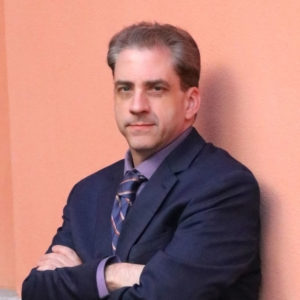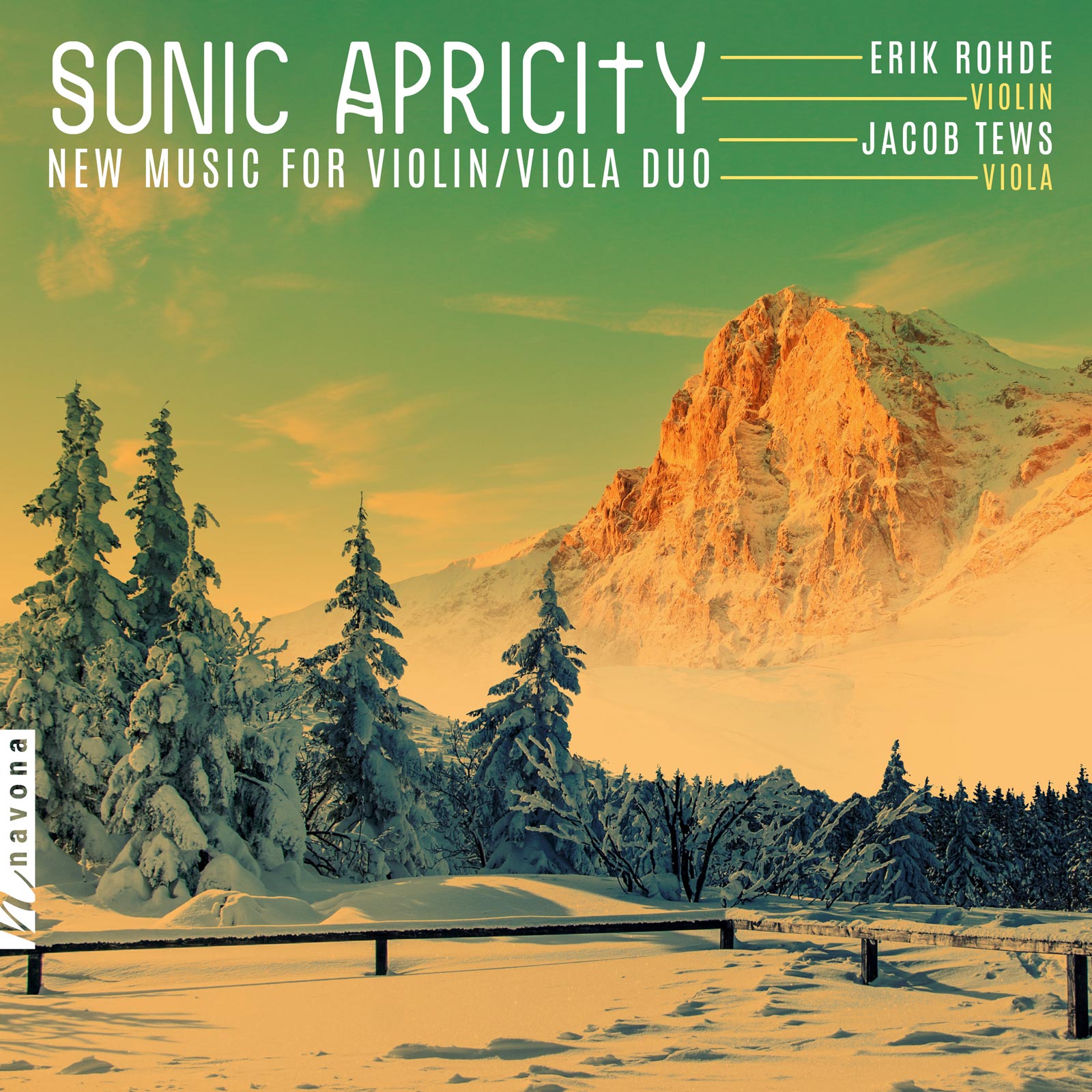Sonic Apricity
Erik Rohde violin
Jacob Tews viola
What happens when you combine a love for uncovering new gems in classical music with two highly skilled performers? Violist Jacob Tews and Violinist Erik Rohde answer this very question with SONIC APRICITY: an album consisting of works they have either commissioned or championed, and the namesake of their musical coalescence.
The duo presents a dynamic selection of new pieces from contemporary composers Augusta Read Thomas, Erzsébet Szőnyi, Elliott Miles McKinley, Christopher Walczak, and Michael-Thomas Foumai, an engaging program of works influenced by poetry, notable tales from pop culture, the passage of time, and more.
Listen
Stream/Buy
Choose your platform
Track Listing & Credits
| # | Title | Composer | Performer | |
|---|---|---|---|---|
| 01 | Rumi Settings: I. Dramatic | Augusta Read Thomas | Erik Rohde, violin; Jacob Tews, viola | 3:13 |
| 02 | Rumi Settings: II. Resonant arpeggio - Prickly, energized | Augusta Read Thomas | Erik Rohde, violin; Jacob Tews, viola | 2:50 |
| 03 | Rumi Settings: III. Suspended and graceful | Augusta Read Thomas | Erik Rohde, violin; Jacob Tews, viola | 2:37 |
| 04 | Rumi Settings: IV. Passionate | Augusta Read Thomas | Erik Rohde, violin; Jacob Tews, viola | 2:19 |
| 05 | Duo for Violin and Viola: I. Allegro | Erzsébet Szőnyi | Erik Rohde, violin; Jacob Tews, viola | 2:15 |
| 06 | Duo for Violin and Viola: II. Appassionato, rubato | Erzsébet Szőnyi | Erik Rohde, violin; Jacob Tews, viola | 1:58 |
| 07 | Duo for Violin and Viola: III. Vivace | Erzsébet Szőnyi | Erik Rohde, violin; Jacob Tews, viola | 1:51 |
| 08 | Dialogues: I. Arguments: Homage to Elliott Carter | Elliott Miles McKinley | Erik Rohde, violin; Jacob Tews, viola | 2:41 |
| 09 | Dialogues: II. Reflection I | Elliott Miles McKinley | Erik Rohde, violin; Jacob Tews, viola | 2:51 |
| 10 | Dialogues: III. Introspection I [viola] | Elliott Miles McKinley | Erik Rohde, violin; Jacob Tews, viola | 0:48 |
| 11 | Dialogues: IV. Meditation | Elliott Miles McKinley | Erik Rohde, violin; Jacob Tews, viola | 8:09 |
| 12 | Dialogues: V. Introspection II [violin] | Elliott Miles McKinley | Erik Rohde, violin; Jacob Tews, viola | 1:48 |
| 13 | Dialogues: VI. Reflection II | Elliott Miles McKinley | Erik Rohde, violin; Jacob Tews, viola | 2:42 |
| 14 | Dialogues: VII. Epilogue: Colloquy | Elliott Miles McKinley | Erik Rohde, violin; Jacob Tews, viola | 4:57 |
| 15 | Flashing Forward Thinking Back | Christopher Walczak | Erik Rohde, violin; Jacob Tews, viola | 6:47 |
| 16 | Scrumdiddlyumptious: I. The Everlasting Double-Triple-Quadruple Stopper | Michael-Thomas Foumai | Erik Rohde, violin; Jacob Tews, viola | 2:19 |
| 17 | Scrumdiddlyumptious: II. Golden Invention | Michael-Thomas Foumai | Erik Rohde, violin; Jacob Tews, viola | 2:46 |
| 18 | Scrumdiddlyumptious: III. Salted Waltz with Spoiled Nuts | Michael-Thomas Foumai | Erik Rohde, violin; Jacob Tews, viola | 1:59 |
| 19 | Scrumdiddlyumptious: IV. Bucket Blues | Michael-Thomas Foumai | Erik Rohde, violin; Jacob Tews, viola | 7:23 |
| 20 | Scrumdiddlyumptious: V. Loompa Loops | Michael-Thomas Foumai | Erik Rohde, violin; Jacob Tews, viola | 1:29 |
| 21 | Scrumdiddlyumptious: VI. Fugue Factory | Michael-Thomas Foumai | Erik Rohde, violin; Jacob Tews, viola | 2:52 |
| 22 | The Dream Angel | Elliott Miles McKinley | Erik Rohde, violin; Jacob Tews, viola; Clare Longendyke, piano | 15:16 |
Rumi Settings, Duo for Violin and Viola, Dialogues
Recorded June 15-17, 2022 at Futura Productions in Roslindale MA
Recording Session Producer Elliott Miles McKinley
Recording Session Engineer John Weston
Flashing Forward Thinking Back, Scrumdiddlyumptious, The Dream Angel
Recorded December 16-18, 2021 at Futura Productions in Roslindale MA
Recording Session Producer Elliott Miles McKinley
Recording Session Engineer John Weston
Label Executive Producer Bob Lord
A&R Director Brandon MacNeil
A&R Jacob Smith
VP of Production Jan Košulič
Audio Director Lucas Paquette
VP of Design & Marketing Brett Picknell
Art Director Ryan Harrison
Design Edward A. Fleming
Publicity Patrick Niland, Aidan Curran
Artist Information

Erik Rohde
Erik Rohde maintains a diverse career as a conductor, violinist, and educator, and has performed in recitals and festivals across the United States and in Europe and Asia. He is the Director of Orchestral Activities at the University of Northern Iowa and the Artistic Director and Conductor of the Winona Symphony Orchestra (MN).

Jacob Tews
Jacob Tews is Assistant Professor of Strings and Orchestra at Christopher Newport University in Newport News VA. He has served previously as an educator at Wartburg College, Southern Illinois University – Carbondale, and the University of Minnesota. He earned a D.M.A. in viola performance, with a secondary emphasis in music theory, from the University of Minnesota.

Elliott Miles McKinley
Elliott Miles McKinley’s music has been performed throughout the United States, Canada, and Europe. Commissions include those from the Pittsburgh New Music Ensemble, the Czech Philharmonic Chamber Music Society, the SOLI Chamber Music Ensemble, Transient Canvas, Hub New Music, the Semiosis String Quartet, the Estrella Consort, the Janàček Trio, and the Martinů String Quartet. His orchestral works have been performed by the Minnesota Orchestra, the Warsaw Philharmonic, and the Czech Radio Symphony, and his music has been featured on international festivals including the Ernest Bloch Music Festival, the SPARK Electroacoustic Music Festival, Society of Music Inc and College Music Society Conferences, the North American Saxophone Alliance National Conference, and the Contemporary Music Festival at Bowling Green State University.

Clare Longendyke
A pianist with “an artistic ferocity that captivated and astonished listeners” (Waverly Newspapers), Clare Longendyke is a soloist, chamber musician, and musical innovator who performs with American orchestras and on recital series around the world. Recent highlights include performances of concertos by Mozart, Falla, Rachmaninoff, Florence Price, and Joan Tower with orchestras in Minnesota, Iowa, Indiana, and Virginia, and the release of her debut solo CD in 2024, …of dreams unveiled featuring works of Debussy, Amy Williams, and Anthony R. Green.

Sonic Apricity
Sonic apricity is a new-music duo composed of violinist Erik Rohde and violist Jacob Tews. Though they have collaborated in various musical contexts for nearly two decades, in 2015 Rohde and Tews saw a neglected area of chamber music repertoire which they wanted to fill. With a presentation at the American Viola Society national conference as an initial public performance, sonic apricity was formed for a specific purpose: the group is dedicated to uncovering and commissioning new works by living composers for violin and viola, performing them alone and in full recitals alongside more established pieces.
Augusta Read Thomas
Augusta Read Thomas’ music is nuanced, majestic, elegant, capricious, and colorful — “it is boldly considered music that celebrates the sound of instruments and reaffirms the vitality of orchestral music” (Philadelphia Inquirer). Her impressive works embody unbridled passion and fierce poetry. The New Yorker called her “a true virtuoso composer.” Critic Edward Reichel wrote, “Thomas has secured for herself a permanent place in the pantheon of American composers of the 20th and 21st centuries. She is without question one of the best and most important composers that this country has today. Her music has substance, depth, and a sense of purpose. She has a lot to say and knows how to say it — and in a way that is intelligent yet appealing and sophisticated.”
Erzsébet Szőnyi
On April 25, 1924, Erzsébet Szőnyi was born in Budapest, the only child of Jenő Szőnyi and Alice Piszanoff. Her father was a bank clerk who loved the arts; he sang, drew, and painted in his spare time. Her mother cared for their home, and played the piano well.
Christopher Walczak
Born in Milwaukee WI and provoked by a family of passionate and latitudinous overachievers, creating music has been a part of everyday life for Christopher Walczak, from kindergarten afternoons until the present. Many years and three degrees later, Walczak finds himself reconciling the kaleidoscopic array of sound and thought absorbed along the way. His repertoire includes works for solo instruments, chamber ensembles of various sizes, full symphony as well as chamber orchestra, music for computer, and interactive electro-acoustic music.
Michael-Thomas Foumai
Michael-Thomas Foumai (b. 1987) is a composer of contemporary concert music, arranger, and educator whose work spans the avant-garde to the commercial. His concert music focuses on storytelling and the history, people, and culture of his Hawaiʻi home. Foumai’s orchestral works have been conducted and performed by Yannick Nézet-Séguin with the Philadelphia Orchestra, Lina Gonzalez-Granados with the National Symphony Orchestra, George Manahan with the American Composers Orchestra at Carnegie Hall, and Osmo Vänskä with the Minnesota Orchestra.

